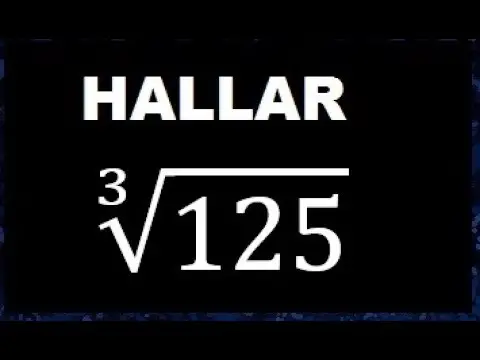
So we can say that 125 to the third power is equal to the cube root of 125. So the answer is going to be five.
What is the cube root of 125 times 8?
Answer: If it is the cube root of 125 as the numerator and 8 as the denominator, the answer is 5/8.
What is the cube root of minus 125?
∛-125 = -5.
What is the number multiplied by 125?
Calculate the following roots. You need to think of a number that multiplied three times by itself, you get 125. So 5 · 5 · 5 = 53 = 125, so the number (the root) is 5.
What number multiplied by three times gives me 125?
→ 3 = 125 . We know that number is 5, because 5,5,5 = 125.
How much is half of 125?
Half of 125 equals 62.5 Half of any number equals dividing the number by 2.
How much is one fifth of 125?
How to find the cube root of 8?
For example: 2 is the cube root of 8 because 2 x 2 x 2 = 8.
What number multiplied by 2 gives 125?
To respond. 125:5×2 I think it is.!
How can multiplication be represented?
Multiplication can be written using three symbols: parentheses, an x-multiply, or a dot. To perform multiplication with factors of two or more digits, you can use the standard method where you multiply each of the numbers in one factor by the numbers in the other factor.
What is the natural number that multiplied by itself is the same?
1 is the neutral element of the multiplication of natural numbers, because every number multiplied by it gives the same number.
Which multiplications give the same result?
One of the most important properties of multiplication is commutativity. Do you remember the famous phrase: “the order of the factors does not change the product”? Well, what that means is that when we multiply two numbers, the order doesn’t matter, the result of the operation will always be the same.
What is room 125?
power/root = 3.3437015248821.
What has 125 half or third?
To respond. 125 is not divisible by 2, because its last digit is not an even number. 125 is not divisible by 3, because the sum of its digits is not a factor of three. Hope it helps u
What is 8 over 125?
The cube root of 8 over 125 equals the fraction of 2/15 (two fifteenths).
What is three fifths of 125?
3/5). 125 = 27/125 .
How many times does 5 go into 125?
5x5x5= 125. What we’ve done is we’ve applied the property, where the bases go down and it solves like a normal equation.
How much is one fifth of 100%?
What is the cube root of 64?
For example, the cube root of 64, written as , is 4 because it is 64. It is also the length of one edge of a cube that has a volume of 64.
What is the cube root of 25?
And we can easily express this in Calc; therefore, the cube root of 25 would be 25^(1/3), since the caret ^ in a formula is the way to express a power.
How many times do you multiply 2 by itself to get 36?
Incorrect. The square root of 36 is the number you can multiply by itself to get 36. The square root is not the number you multiply by 2 to get 36. The correct answer is 6 because 6.
What number multiplied by 2 gives 144?
12 • (6 • 2) = 144 is rewritten as (12 • 6) • 2 = 144.
What number multiplied by itself three times equals 64?
The answer is 4: if we multiply 4 three times by itself (4 x 4 x 4), we will see that the result is 64. Therefore, 4 cubed equals 64 (and the cube root of 64 is 4).
What are the division parts called?
Dividend is the number to be divided. Divisor is the number that divides. Quotient is the result of division. The remainder is what is left over from the dividend, which could not be divided because it is less than the divisor.
What are the terms of splitting Wikipedia?
Given two natural numbers, the dividend, m, and the divisor, d, which must be greater than zero, we call the quotient, q, the largest of the numbers that multiplied by the divisor is less than or equal to the dividend. We call the remainder, r, the difference between the dividend and the product of the quotient and the divisor.
What are the rules for multiplying by 10, 100, and 1000?
The principle we discovered for 10, 100, and 1000 can be applied when one of the factors of a multiplication is a followed by another number of zeros (10,000; 100,000; 1,000,000, for example).